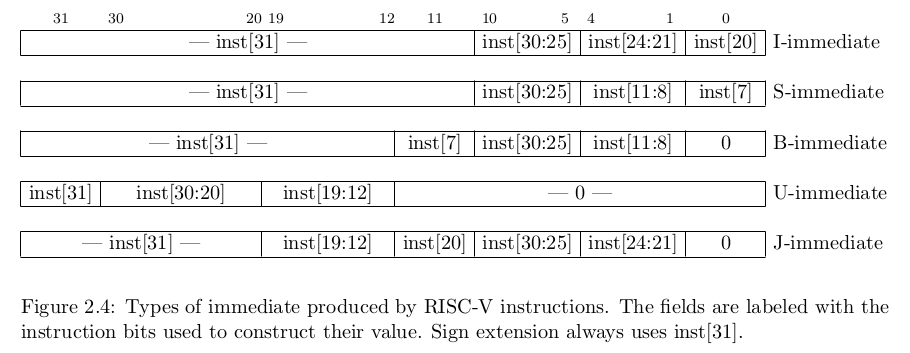To speed up decoding, the base RISC-V ISA puts the most important fields in the same place in every instruction. As you can see in the instruction formats table,
- The major opcode is always in bits 0-6.
- The destination register, when present, is always in bits 7-11.
- The first source register, when present, is always in bits 15-19.
- The second source register, when present, is always in bits 20-24.
The other bits are used for the minor opcode or other data for the instruction (funct3 in bits 12-14 and funct7 in bits 25-31), and for the immediate. How many bits can be used for the immediate depends on how many register numbers are present in the instruction:
- Instructions with one destination and two source registers (R-type) have no immediate, for instance adding two registers (
ADD);
- Instructions with one destination and one source register (I-type) have 12 bits for the immediate, for instance adding one register with an immediate (
ADDI);
- Instructions with two source registers and no destination register (S-type), for instance the store instructions, have also 12 bits for the immediate, but they have to be in a different place since the register numbers are also in a different place;
- Finally, instructions with only a destination register and no minor opcode (U-type), for instance
LUI, can use 20 bits for the immediate (the major opcode and the destination register number together need 12 bits).
Now think from the other point of view, of the instructions which will use these immediate values. The simplest users, I-immediate and S-immediate, need only a sign-extended 12-bit value. The U-immediate instructions need the immediate in the upper 20 bits of a 32-bit value. Finally, the branch/jump instructions need the sign-extended immediate in the lower bits of the value, except for the lowest bit which will always be zero, since RISC-V instructions are always aligned to even addresses.
But why are the immediate bits shuffled? Think this time about the physical circuit which decodes the immediate field. Since it's a hardware implementation, the bits will be decoded in parallel; each bit in the output immediate will have a multiplexer to select which input bit it comes from. The bigger the multiplexer, the costlier and slower it is.
The "shuffling" of the immediate bits in the instruction encoding, therefore, is to make each output immediate bit have as little input instruction bit options as possible. For instance, immediate bit 1 can only come from instruction bits 8 (S-immediate or B-immediate), 21 (I-immediate or J-immediate), or constant zero (U-immediate or R-type instruction which has no immediate). Immediate bit 0 can come from instruction bits 7 (S-immediate), 20 (I-immediate), or constant zero. Immediate bit 5 can only come from instruction bit 25 or constant zero. And so on.
Instruction bit 31 is a special case: for RV-64, bits 32-63 of the immediate are always copies of instruction bit 31. This high fan-out adds a delay, which would be even bigger if it also needed a multiplexer, so it only has one option (other than constant zero, which can be treated later in the pipeline by ignoring the whole immediate).
It's also interesting to note that only the major opcode (bits 0-6) is needed to know how to decode the immediate, so immediate decoding can be done in parallel with decoding the rest of the instruction.
So, answering the questions:
- SB-type doubles the range of branches, since instructions are always aligned to even addresses;
- UJ-type has the same overall instruction format as U-type, but the immediate value is in the lower bits instead of the upper bits;
- The immediate bits are shuffled to reduce the cost of decoding the immediate value, by reducing the number of choices for each output immediate bit;
- The "immediate produced by RISC-V instructions" table shows the different kinds of immediate values which can be decoded from a RISC-V instruction, and from where in the instruction each bit comes from;
- They are produced by, for each output immediate bit, using the major opcode (bits 0-6) to chose an input instruction bit.


